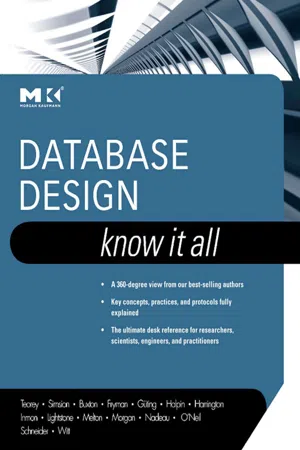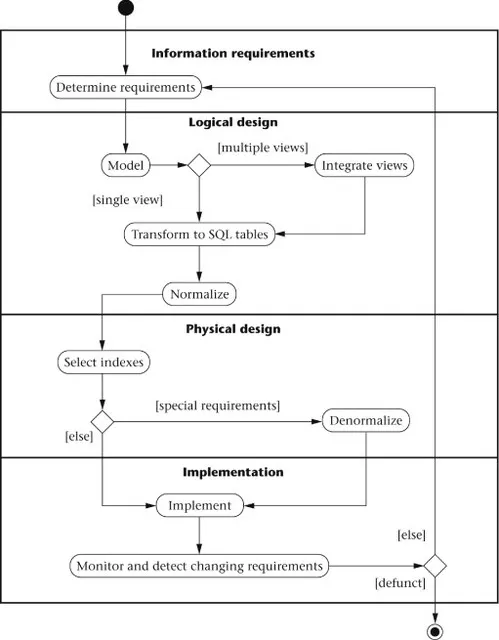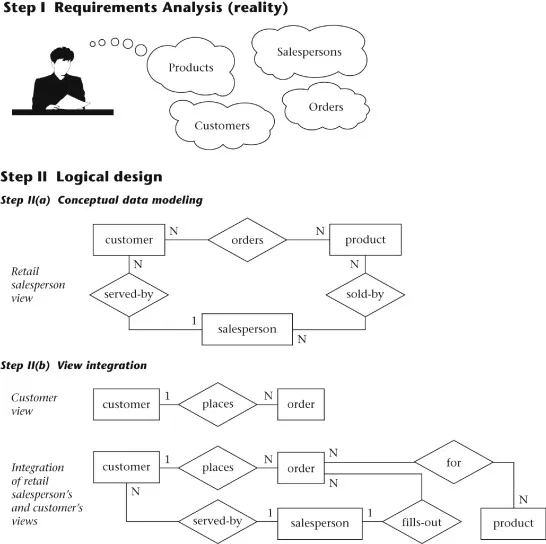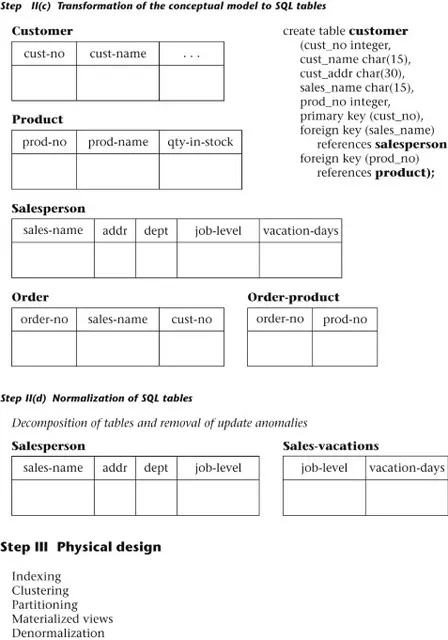
- 368 pages
- English
- ePUB (mobile friendly)
- Available on iOS & Android
About This Book
This book brings all of the elements of database design together in a single volume, saving the reader the time and expense of making multiple purchases. It consolidates both introductory and advanced topics, thereby covering the gamut of database design methodology? from ER and UML techniques, to conceptual data modeling and table transformation, to storing XML and querying moving objects databases. The proposed book expertly combines the finest database design material from the Morgan Kaufmann portfolio. Individual chapters are derived from a select group of MK books authored by the best and brightest in the field. These chapters are combined into one comprehensive volume in a way that allows it to be used as a reference work for those interested in new and developing aspects of database design. This book represents a quick and efficient way to unite valuable content from leading database design experts, thereby creating a definitive, one-stop-shopping opportunity for customers to receive the information they would otherwise need to round up from separate sources.
- Chapters contributed by various recognized experts in the field let the reader remain up to date and fully informed from multiple viewpoints.
- Details multiple relational models and modeling languages, enhancing the reader's technical expertise and familiarity with design-related requirements specification.
- Coverage of both theory and practice brings all of the elements of database design together in a single volume, saving the reader the time and expense of making multiple purchases.
Frequently asked questions
Information
Chapter 1. Introduction
1.1. Data and Database Management
1.2. The Database Life Cycle
Figure 1.1. The database life cycle.

Figure 1.2. Life cycle results, step-by-step.


- Requirements analysis. The database requirements are determined by interviewing both the producers and users of data and using the information to produce a formal requirements specification. That specification includes the data required for processing, the natural data relationships, and the software platform for the database implementation. As an example, Figure 1.2 (step I) shows the concepts of products, customers, salespersons, and orders being formulated in the mind of the end user during the interview process.
- Logical design. The global schema, a conceptual data model diagram that shows all the data and their relationships, is developed using techniques such as entity–relationship (ER) or UML. The data model constructs must ultimately be transformed into normalized (global) relations, or tables. The global schema development methodology is the same for either a distributed or centralized database.
- Conceptual data modeling. The data requirements are analyzed and modeled using an ER or UML diagram that includes, for example, semantics for optional relationships, ternary relationships, supertypes, and subtypes (categories). Processing requirements are typically specified using natural language expressions or SQL commands, along with the frequency of occurrence. Figure 1.2 (step II(a)) shows a possible ER model representation of the product/customer database in the mind of the end user.
- View integration. Usually, when the design is large and more than one person is involved in requirements analysis, multiple views of data and relationships result. To eliminate redundancy and inconsistency from the model, these views eventually must be “rationalized” (resolving inconsistencies due to variance in taxonomy, context, or perception) and then consolidated into a single global view. View integration requires the use of ER semantic tools such as identification of synonyms, aggregation, and generalization. In Figure 1.2 (step II(b)), two possible views of the product/customer database are merged into a single global view based on common data for customer and order. View integration is also important for application integration.
- Transformation of the conceptual data model to SQL tables. Based on a categorization of data modeling constructs and a set of mapping rules, each relationship and its associated entities are transformed into a set of DBMS-specific candidate relational tables. Redundant tables are eliminated as part of this process. In our example, the tables in step II(c) of Figure 1.2 are the result of transformation of the integrated ER model in step II(b).
- Normalization of tables. Functional dependencies (FDs) are derived from the conceptual data model diagram and the semantics of data relationships in the requirements analysis. They represent the dependencies among data elements that are unique identifiers (keys) of entities. Additional FDs that represent the dependencies among key and nonkey attributes within entities can be derived from the requirements specification. Candidate relational tables associated with all derived FDs are normalized (i.e., modified by decomposing or splitting tables into smaller tables) using standard techniques. Finally, redundancies in the data in normalized candidate tables are analyzed further for possible elimination, with the constraint that data integrity must be preserved. An example of normalization of the Salesperson table into the new Salesperson and Sales-vacations tables is shown in Figure 1.2 from step II(c) to step II(d).We note here that database tool vendors tend to use the term logical model to refer to the conceptual data model, and they use the term physical model to refer to the DBMS-specific implementation model (e.g., SQL tables). Note also that many conceptual data models are obtained not from scratch, but from the process of reverse engineering from an existing DBMS-specific schema (Silberschatz, Korth, & Sudarshan, 2002).
- Physical design. The physical design step involves the selection of indexes (access methods), partitioning, and clustering of data. The logical design methodology in step II simplifies the approach to designing large relational databases by reducing the number of data dependencies that need to be analyzed. This is accomplished by inserting conceptual data modeling and integration steps (II(a) and II(b) of Figure 1.2) into the traditional relational design approach. The objective of these steps is an accurate representation of reality. Data integrity is preserved through normalization of the candidate tables created when the conceptual data model is transformed into a relational model. The purpose of physical design is to optimize performance as closely as possible.As part of the physical design, the global schema can sometimes be refined in limited ways to reflect processing (query and transaction) requirements if there are obvious, large gains to be made in efficiency. This is called denormalization. It consists of selecting dominant processes on the basis of high frequency, high volume, or explicit priority; defining simple extensions to tables that will improve query performance; evaluating total cost for query, update, and storage; and considering the side effects, such as possible loss of integrity. This is particularly important for Online Analytical Processing (OLAP) applications.
- Database implementation, monitoring, and modification. Once the design is completed, the database can be created through implementation of the formal schema using the data definition language (DDL) of a DBMS. Then the data manipulation language (DML) can be used to query and update the database, as well as to set up indexes and establish constraints, such as referential integrity. The language SQL contains both DDL and DML constructs; for example, the create table command represents DDL, and the select command represents DML.As the database begins operation, monitoring indicates whether performance requirements are being met. If they are not being satisfied, modifications should be...
Table of contents
- Copyright
- Brief Table of Contents
- Table of Contents
- List of Figures
- List of Tables
- Copyright Page
- About This Book
- Contributing Authors
- Chapter 1. Introduction
- Chapter 2. Entity–Relationship Concepts
- Chapter 3. Data Modeling in UML
- Chapter 4. Requirements Analysis and Conceptual Data Modeling
- Chapter 5. Logical Database Design
- Chapter 6. Normalization
- Chapter 7. Physical Database Design
- Chapter 8. Denormalization
- Chapter 9. Business Metadata Infrastructure
- Chapter 10. Storing
- Chapter 11. Modeling and Querying Current Movement
- Index